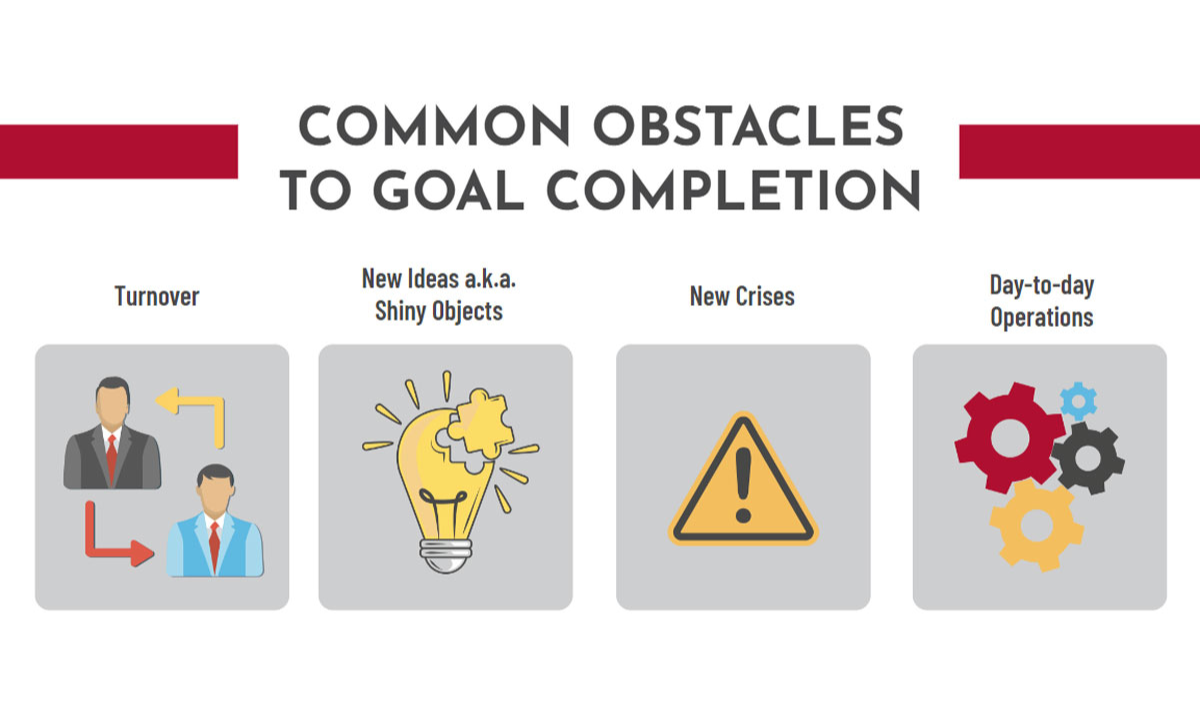Systems to accomplish the goals set during a dental company’s annual planning meeting.
Winning the game before it starts means planning ahead and setting clear and achievable goals for the future.
Annual planning can help your organization do this and is a form of strategic goal setting that begins with company leaders and trickles down to specific project and task execution within dental teams.
Unfortunately for many companies, things discussed at annual planning meetings are like New Year’s Resolutions – goals that leaders get excited about but within a couple of weeks lose focus or momentum due to unclear objectives, staffing turnover, crisis management, or even lack of the systems necessary to implement the ideas.
While there may be valid reasons for not following through with the goals and priorities created during an annual meeting, it sends the wrong message to team members that:
- Leadership doesn’t have the integrity to follow through on their goals and vision.
- Leadership is not competent at setting goals that matter and stand the test of time.
- Team members shouldn’t get too invested in any new goals/projects because leadership will probably change their minds soon anyway.
- The squeaky wheel gets priority.
Fortunately, there are systems and processes that can be enacted during a dental team’s annual planning meeting to successfully achieve company priorities. If teams are given easy-to-understand and attainable projects based on systems, they can have a clearer approach and be more likely to accomplish objectives.
Before the meeting
Annual planning should consist of a one- to two-day meeting that includes each of the leaders and executives within a dental practice. But too often, the leadership team comes into these meetings flat-footed because they didn’t do the necessary prep work.
Before the meeting, leaders should gather the needs of each practice, and team, far in advance, so that everyone arrives ready and prepared to discuss ideas. These internal team meetings are an opportunity to listen to everything that is needed within a company, considering everyone’s perspective – from the front desk to the doctors. This provides the leadership team with a more grounded look at what the organization needs.
Leaders should immediately put their team’s list of ideas into a document, using organizational tools such as Google Docs, Asana, or a spreadsheet (find a place that works best for the company). All ideas should be documented in one place (such as a specific planning meeting spreadsheet), including the name of the idea and what team/individual that the idea originated from. Once the individual team meetings and idea spreadsheet are complete, leaders will be prepared for the annual meeting.
IDOPE for annual planning
Dental leaders can use a tried-and-true project management system called IDOPE for the annual planning meeting. The first step, ideate, is covered with those internal team member meetings to generate ideas. From there:
- Document. If ideas aren’t written down, it’s harder to judge them, evaluate them, or determine their value. Don’t worry about determining all the details about an idea at this stage. The goal is just to capture the gist of the idea.
- Organize. Flesh out all ideas with a description of the scope of the idea/project, the ROI for the project, who the lead would be on completing the project, and who would be consulted on this project.
- Prioritize. Weigh the ideas against each other based on revenue vs. expense. Look at the project lead to see whether one team or individual is being overloaded. Look at the amount of effort and time it might take to accomplish this idea. Order your priorities accordingly, and confirm buy-in from all leaders on this prioritization.
But which ideas should be at the top of the list? The DEO has two helpful tools to help leaders in this area. The first is called the Customer Stack Tool. This tool asks the questions, “How would this idea impact [fill in the blank with your primary customer]?” Another useful tool is DEO’s Constraint Assessment List. This resource has a 15-point checklist including financials, collections rate, scheduling availability, facility capacity, staffing model management team, and more – which can help dental practices determine which goals to focus on as a company first.
Prioritize the projects that directly benefit the customer first, as they are the primary revenue source. Focus on goals that meet the needs of patients first, then clinicians, dental assistants, and treatment coordinators. If all those priorities are already met, then move to projects centered around scheduling, collections, marketing, and support services.
Remember when determining year-long priorities to consider the availability of a company’s resources and if there is time to explain and clarify systems around the project for each team. Ordering priorities correctly is essential to their completion.
| Elements of an annual planning meeting • Do some legwork in advance • Get away from your day-to-day environment • Include team-building activities • Review the past year – Look at what worked • Review the past year – Look at what didn’t work • Determine organizational needs • Reverse engineer your goals • Handoff to a project manager IDOPE The annual planning process requires: I – Ideate: One individual to collect ideas D – Document: A place to document ideas O – Organize: A place to organize ideas P – Prioritize: A method for prioritizing ideas E – Execute: A process for executing on ideas |
Execute
The final step of the annual planning meeting is to create a process for executing ideas. Determine clear systems that ensure that the project will be completed at a high level by teams. Leaders can accomplish this by setting a deadline for completing the project, having a clear, updated status of the project in a shared document that is consistently monitored, and encouraging staff to update the project spreadsheet frequently with a percentage of project completeness.
Leaders should also outline the next actions for all projects in the document for staff’s continued progress, including notes and links to help dental teams complete the project successfully.
Building out systems takes a company’s annual planning meeting to the next level, growing the team’s integrity and success.
The more a system and process are fleshed out in the annual planning meeting, the better teams can accomplish annual goals. If leaders plan and prioritize ideas that focus on patients and office staff while clearly defining the system and process for accomplishing each goal, annual planning meetings can run smoothly and set up teams for success in the upcoming year.





